Aposematism: Diversification of Aposematic Signals Analysis Report
VerifiedAdded on 2021/08/03
|22
|7508
|151
Report
AI Summary
This report delves into the phenomenon of aposematism, particularly focusing on the diversification of aposematic signals within the framework of Müllerian mimicry, using the example of the Ranitomeya imitator frog. It explores the spatial variation in selection pressures caused by different predators, hypothesizing that this is the driving force behind the impressive variations observed in aposematic patterns across small spatial scales. The study combines population genetics and ecological tools to analyze the transition between geographic systems characterized by distinct aposematic patterns. The report refutes the premise that R. imitator converges to the aposematic signal of another species, highlighting that predation varies spatially, creating a heterogeneous landscape of selection pressures. The study highlights how dynamic Müllerian mimicry systems can be, demonstrating how the spatial alternation between neutral evolutionary processes and natural selection allows the emergence of new aposematic phenotypes and the geographic organization of warning signals.
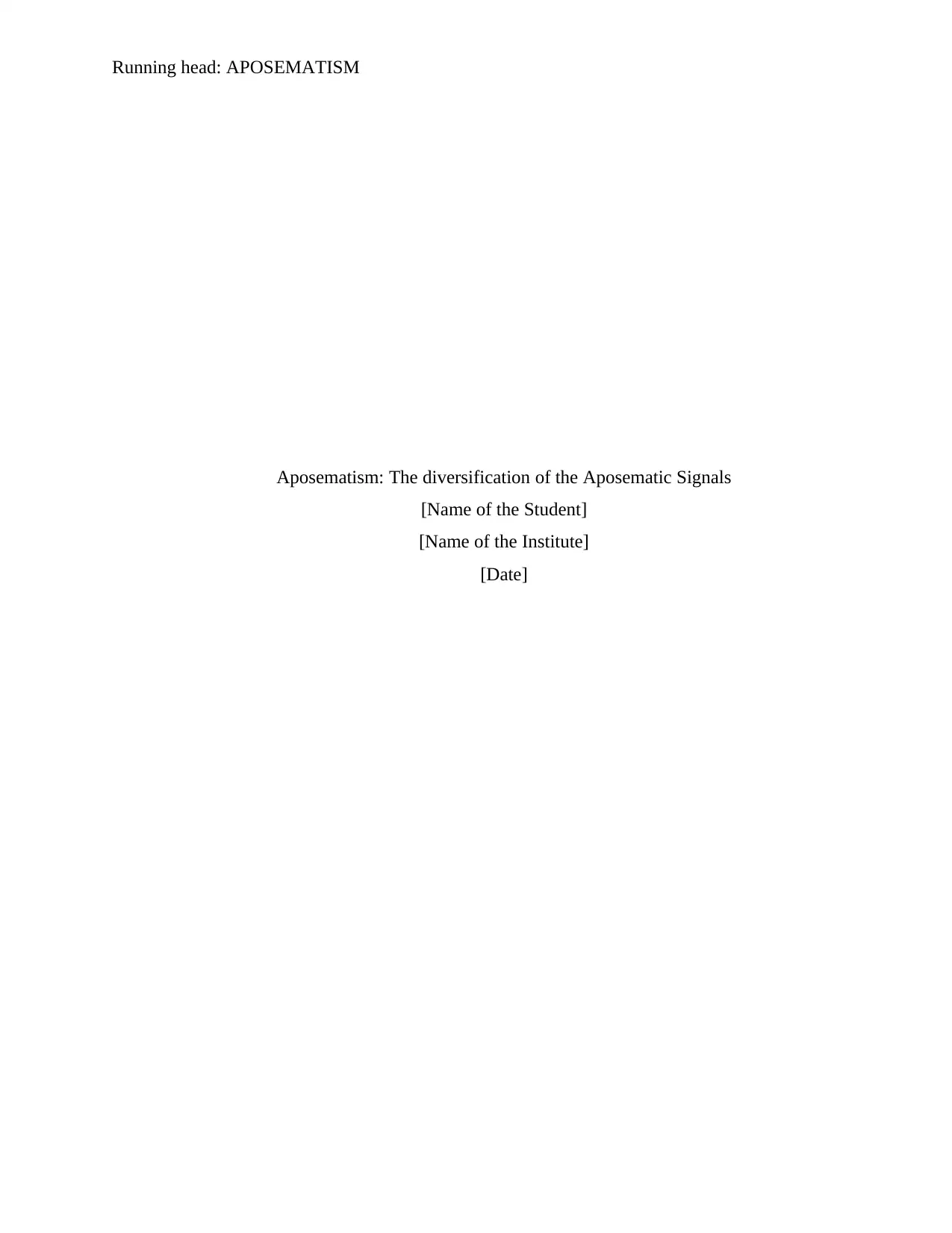
Running head: APOSEMATISM
Aposematism: The diversification of the Aposematic Signals
[Name of the Student]
[Name of the Institute]
[Date]
Aposematism: The diversification of the Aposematic Signals
[Name of the Student]
[Name of the Institute]
[Date]
Paraphrase This Document
Need a fresh take? Get an instant paraphrase of this document with our AI Paraphraser
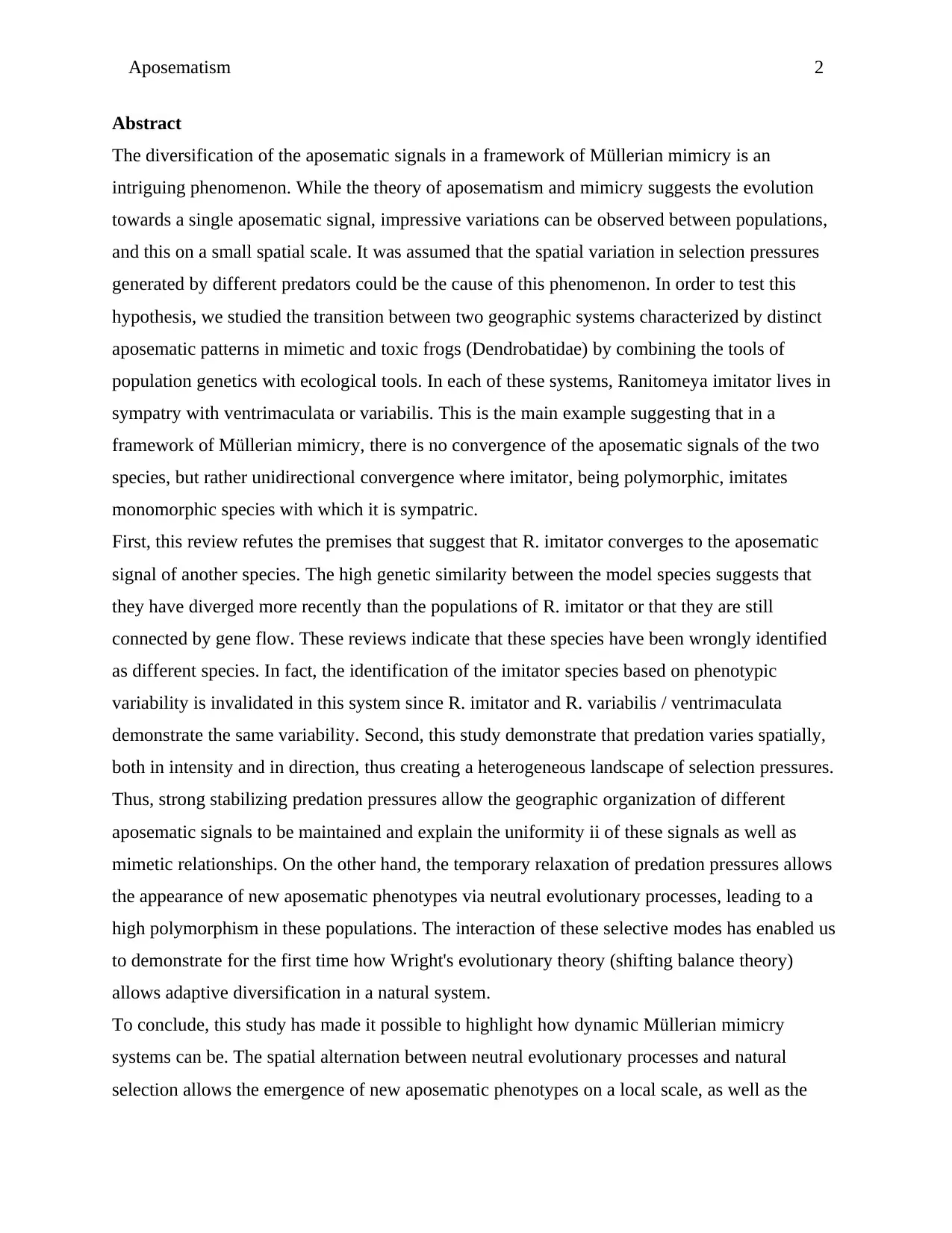
Aposematism 2
Abstract
The diversification of the aposematic signals in a framework of Müllerian mimicry is an
intriguing phenomenon. While the theory of aposematism and mimicry suggests the evolution
towards a single aposematic signal, impressive variations can be observed between populations,
and this on a small spatial scale. It was assumed that the spatial variation in selection pressures
generated by different predators could be the cause of this phenomenon. In order to test this
hypothesis, we studied the transition between two geographic systems characterized by distinct
aposematic patterns in mimetic and toxic frogs (Dendrobatidae) by combining the tools of
population genetics with ecological tools. In each of these systems, Ranitomeya imitator lives in
sympatry with ventrimaculata or variabilis. This is the main example suggesting that in a
framework of Müllerian mimicry, there is no convergence of the aposematic signals of the two
species, but rather unidirectional convergence where imitator, being polymorphic, imitates
monomorphic species with which it is sympatric.
First, this review refutes the premises that suggest that R. imitator converges to the aposematic
signal of another species. The high genetic similarity between the model species suggests that
they have diverged more recently than the populations of R. imitator or that they are still
connected by gene flow. These reviews indicate that these species have been wrongly identified
as different species. In fact, the identification of the imitator species based on phenotypic
variability is invalidated in this system since R. imitator and R. variabilis / ventrimaculata
demonstrate the same variability. Second, this study demonstrate that predation varies spatially,
both in intensity and in direction, thus creating a heterogeneous landscape of selection pressures.
Thus, strong stabilizing predation pressures allow the geographic organization of different
aposematic signals to be maintained and explain the uniformity ii of these signals as well as
mimetic relationships. On the other hand, the temporary relaxation of predation pressures allows
the appearance of new aposematic phenotypes via neutral evolutionary processes, leading to a
high polymorphism in these populations. The interaction of these selective modes has enabled us
to demonstrate for the first time how Wright's evolutionary theory (shifting balance theory)
allows adaptive diversification in a natural system.
To conclude, this study has made it possible to highlight how dynamic Müllerian mimicry
systems can be. The spatial alternation between neutral evolutionary processes and natural
selection allows the emergence of new aposematic phenotypes on a local scale, as well as the
Abstract
The diversification of the aposematic signals in a framework of Müllerian mimicry is an
intriguing phenomenon. While the theory of aposematism and mimicry suggests the evolution
towards a single aposematic signal, impressive variations can be observed between populations,
and this on a small spatial scale. It was assumed that the spatial variation in selection pressures
generated by different predators could be the cause of this phenomenon. In order to test this
hypothesis, we studied the transition between two geographic systems characterized by distinct
aposematic patterns in mimetic and toxic frogs (Dendrobatidae) by combining the tools of
population genetics with ecological tools. In each of these systems, Ranitomeya imitator lives in
sympatry with ventrimaculata or variabilis. This is the main example suggesting that in a
framework of Müllerian mimicry, there is no convergence of the aposematic signals of the two
species, but rather unidirectional convergence where imitator, being polymorphic, imitates
monomorphic species with which it is sympatric.
First, this review refutes the premises that suggest that R. imitator converges to the aposematic
signal of another species. The high genetic similarity between the model species suggests that
they have diverged more recently than the populations of R. imitator or that they are still
connected by gene flow. These reviews indicate that these species have been wrongly identified
as different species. In fact, the identification of the imitator species based on phenotypic
variability is invalidated in this system since R. imitator and R. variabilis / ventrimaculata
demonstrate the same variability. Second, this study demonstrate that predation varies spatially,
both in intensity and in direction, thus creating a heterogeneous landscape of selection pressures.
Thus, strong stabilizing predation pressures allow the geographic organization of different
aposematic signals to be maintained and explain the uniformity ii of these signals as well as
mimetic relationships. On the other hand, the temporary relaxation of predation pressures allows
the appearance of new aposematic phenotypes via neutral evolutionary processes, leading to a
high polymorphism in these populations. The interaction of these selective modes has enabled us
to demonstrate for the first time how Wright's evolutionary theory (shifting balance theory)
allows adaptive diversification in a natural system.
To conclude, this study has made it possible to highlight how dynamic Müllerian mimicry
systems can be. The spatial alternation between neutral evolutionary processes and natural
selection allows the emergence of new aposematic phenotypes on a local scale, as well as the

Aposematism 3
appearance of a geographic organization of warning signals and of Mullerian mimicry
relationships.
Keywords: Aposematism, mimicry, polymorphism, spatial structure, predation,
diversification.
appearance of a geographic organization of warning signals and of Mullerian mimicry
relationships.
Keywords: Aposematism, mimicry, polymorphism, spatial structure, predation,
diversification.
⊘ This is a preview!⊘
Do you want full access?
Subscribe today to unlock all pages.

Trusted by 1+ million students worldwide
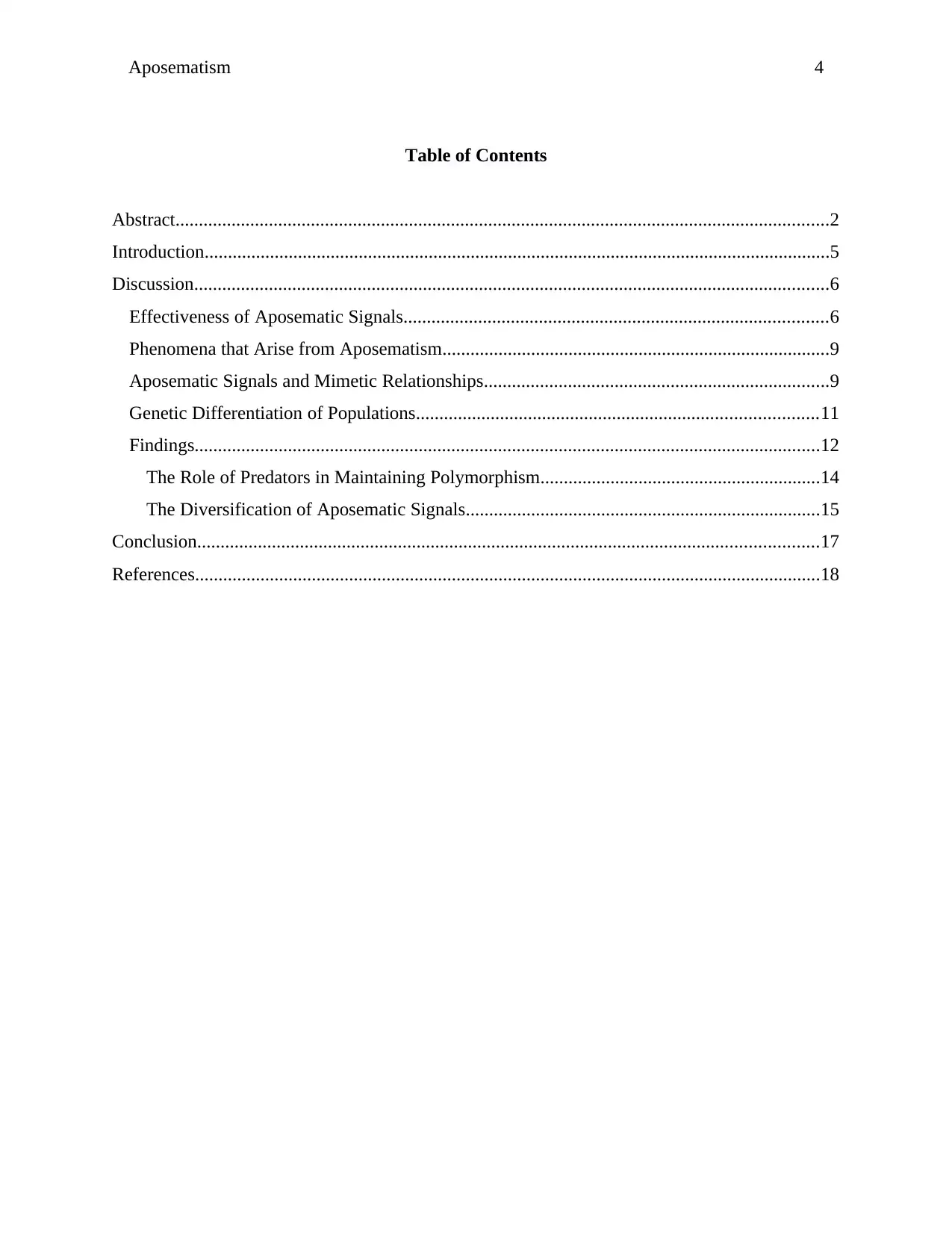
Aposematism 4
Table of Contents
Abstract............................................................................................................................................2
Introduction......................................................................................................................................5
Discussion........................................................................................................................................6
Effectiveness of Aposematic Signals...........................................................................................6
Phenomena that Arise from Aposematism...................................................................................9
Aposematic Signals and Mimetic Relationships..........................................................................9
Genetic Differentiation of Populations......................................................................................11
Findings......................................................................................................................................12
The Role of Predators in Maintaining Polymorphism............................................................14
The Diversification of Aposematic Signals............................................................................15
Conclusion.....................................................................................................................................17
References......................................................................................................................................18
Table of Contents
Abstract............................................................................................................................................2
Introduction......................................................................................................................................5
Discussion........................................................................................................................................6
Effectiveness of Aposematic Signals...........................................................................................6
Phenomena that Arise from Aposematism...................................................................................9
Aposematic Signals and Mimetic Relationships..........................................................................9
Genetic Differentiation of Populations......................................................................................11
Findings......................................................................................................................................12
The Role of Predators in Maintaining Polymorphism............................................................14
The Diversification of Aposematic Signals............................................................................15
Conclusion.....................................................................................................................................17
References......................................................................................................................................18
Paraphrase This Document
Need a fresh take? Get an instant paraphrase of this document with our AI Paraphraser
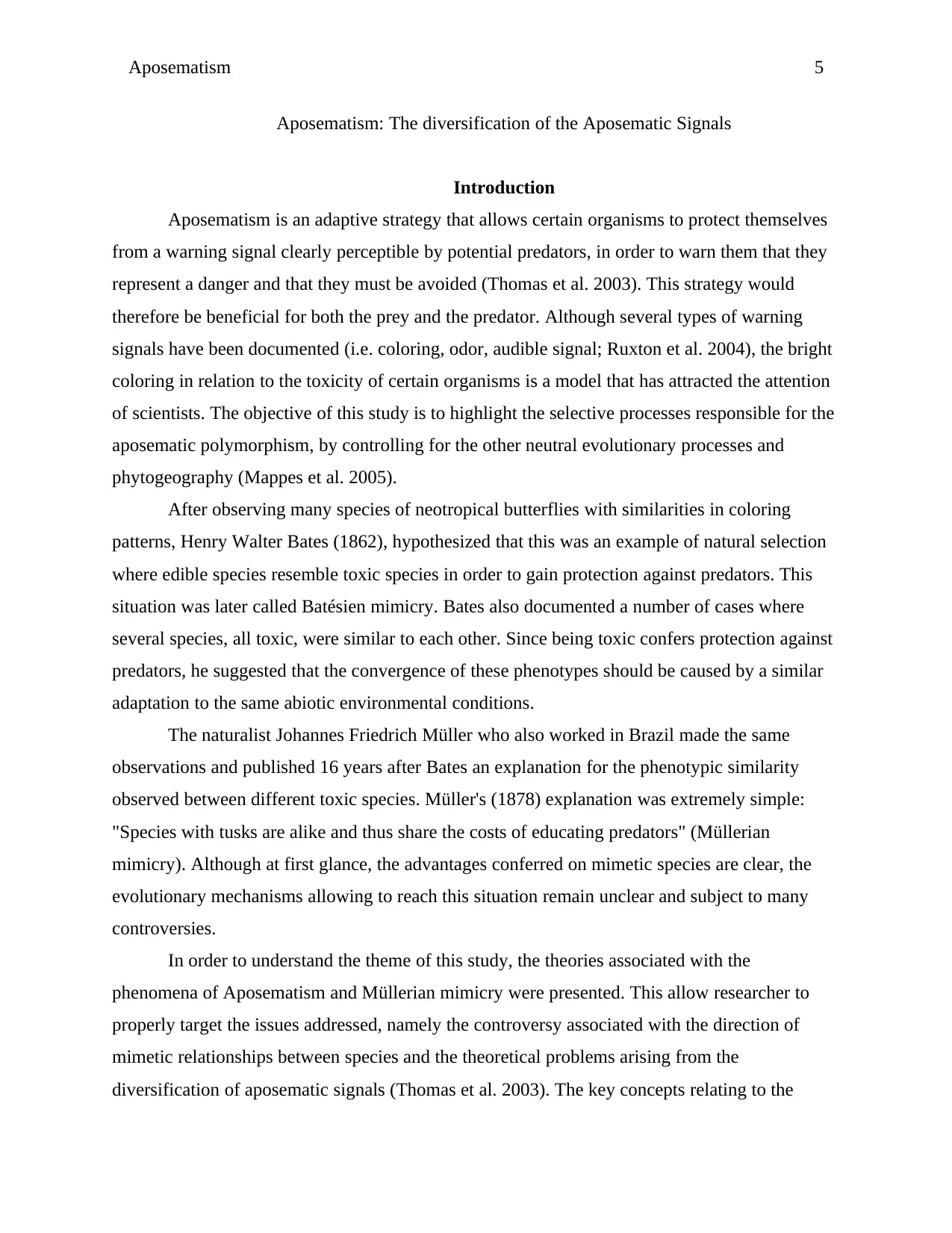
Aposematism 5
Aposematism: The diversification of the Aposematic Signals
Introduction
Aposematism is an adaptive strategy that allows certain organisms to protect themselves
from a warning signal clearly perceptible by potential predators, in order to warn them that they
represent a danger and that they must be avoided (Thomas et al. 2003). This strategy would
therefore be beneficial for both the prey and the predator. Although several types of warning
signals have been documented (i.e. coloring, odor, audible signal; Ruxton et al. 2004), the bright
coloring in relation to the toxicity of certain organisms is a model that has attracted the attention
of scientists. The objective of this study is to highlight the selective processes responsible for the
aposematic polymorphism, by controlling for the other neutral evolutionary processes and
phytogeography (Mappes et al. 2005).
After observing many species of neotropical butterflies with similarities in coloring
patterns, Henry Walter Bates (1862), hypothesized that this was an example of natural selection
where edible species resemble toxic species in order to gain protection against predators. This
situation was later called Batésien mimicry. Bates also documented a number of cases where
several species, all toxic, were similar to each other. Since being toxic confers protection against
predators, he suggested that the convergence of these phenotypes should be caused by a similar
adaptation to the same abiotic environmental conditions.
The naturalist Johannes Friedrich Müller who also worked in Brazil made the same
observations and published 16 years after Bates an explanation for the phenotypic similarity
observed between different toxic species. Müller's (1878) explanation was extremely simple:
"Species with tusks are alike and thus share the costs of educating predators" (Müllerian
mimicry). Although at first glance, the advantages conferred on mimetic species are clear, the
evolutionary mechanisms allowing to reach this situation remain unclear and subject to many
controversies.
In order to understand the theme of this study, the theories associated with the
phenomena of Aposematism and Müllerian mimicry were presented. This allow researcher to
properly target the issues addressed, namely the controversy associated with the direction of
mimetic relationships between species and the theoretical problems arising from the
diversification of aposematic signals (Thomas et al. 2003). The key concepts relating to the
Aposematism: The diversification of the Aposematic Signals
Introduction
Aposematism is an adaptive strategy that allows certain organisms to protect themselves
from a warning signal clearly perceptible by potential predators, in order to warn them that they
represent a danger and that they must be avoided (Thomas et al. 2003). This strategy would
therefore be beneficial for both the prey and the predator. Although several types of warning
signals have been documented (i.e. coloring, odor, audible signal; Ruxton et al. 2004), the bright
coloring in relation to the toxicity of certain organisms is a model that has attracted the attention
of scientists. The objective of this study is to highlight the selective processes responsible for the
aposematic polymorphism, by controlling for the other neutral evolutionary processes and
phytogeography (Mappes et al. 2005).
After observing many species of neotropical butterflies with similarities in coloring
patterns, Henry Walter Bates (1862), hypothesized that this was an example of natural selection
where edible species resemble toxic species in order to gain protection against predators. This
situation was later called Batésien mimicry. Bates also documented a number of cases where
several species, all toxic, were similar to each other. Since being toxic confers protection against
predators, he suggested that the convergence of these phenotypes should be caused by a similar
adaptation to the same abiotic environmental conditions.
The naturalist Johannes Friedrich Müller who also worked in Brazil made the same
observations and published 16 years after Bates an explanation for the phenotypic similarity
observed between different toxic species. Müller's (1878) explanation was extremely simple:
"Species with tusks are alike and thus share the costs of educating predators" (Müllerian
mimicry). Although at first glance, the advantages conferred on mimetic species are clear, the
evolutionary mechanisms allowing to reach this situation remain unclear and subject to many
controversies.
In order to understand the theme of this study, the theories associated with the
phenomena of Aposematism and Müllerian mimicry were presented. This allow researcher to
properly target the issues addressed, namely the controversy associated with the direction of
mimetic relationships between species and the theoretical problems arising from the
diversification of aposematic signals (Thomas et al. 2003). The key concepts relating to the
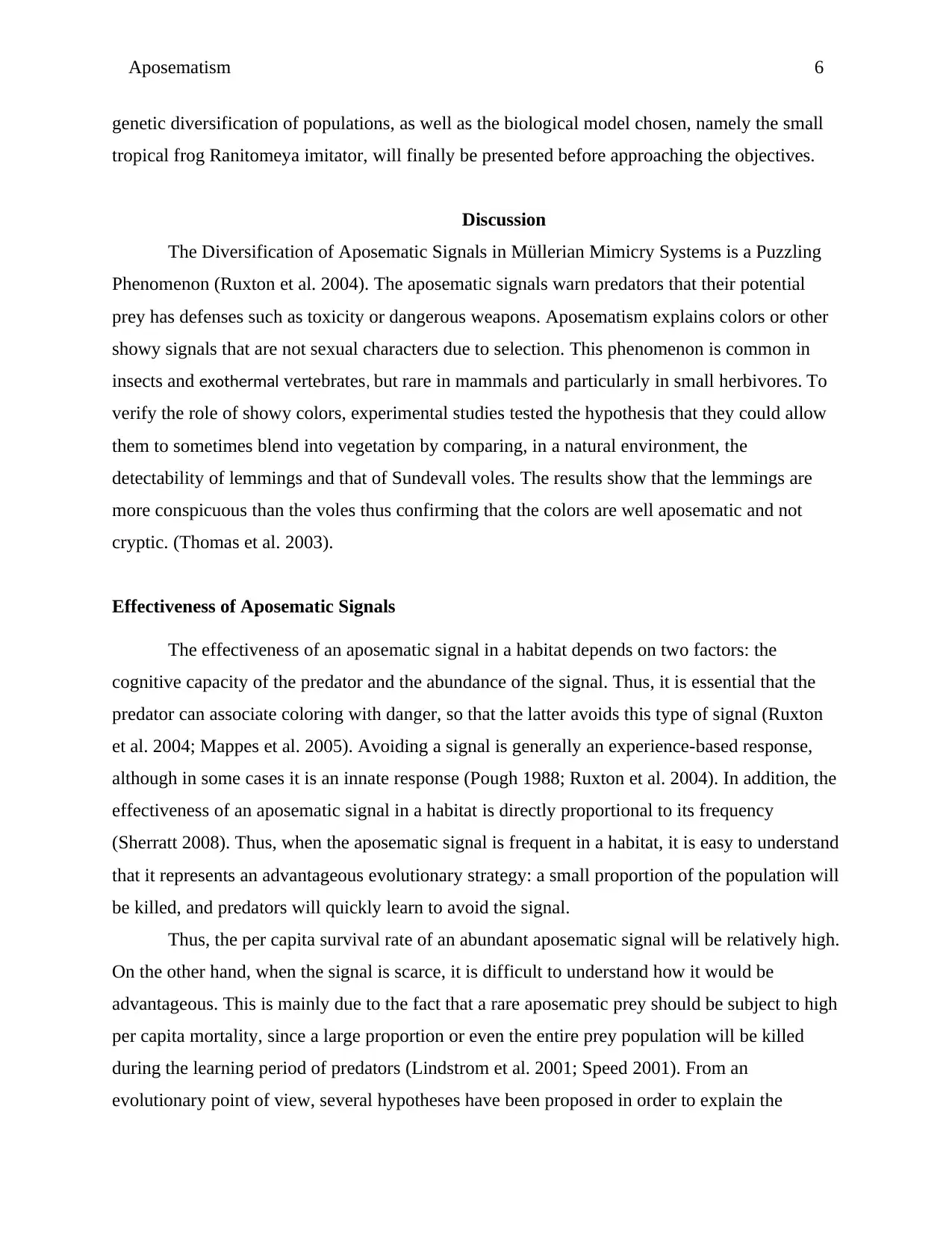
Aposematism 6
genetic diversification of populations, as well as the biological model chosen, namely the small
tropical frog Ranitomeya imitator, will finally be presented before approaching the objectives.
Discussion
The Diversification of Aposematic Signals in Müllerian Mimicry Systems is a Puzzling
Phenomenon (Ruxton et al. 2004). The aposematic signals warn predators that their potential
prey has defenses such as toxicity or dangerous weapons. Aposematism explains colors or other
showy signals that are not sexual characters due to selection. This phenomenon is common in
insects and exothermal vertebrates, but rare in mammals and particularly in small herbivores. To
verify the role of showy colors, experimental studies tested the hypothesis that they could allow
them to sometimes blend into vegetation by comparing, in a natural environment, the
detectability of lemmings and that of Sundevall voles. The results show that the lemmings are
more conspicuous than the voles thus confirming that the colors are well aposematic and not
cryptic. (Thomas et al. 2003).
Effectiveness of Aposematic Signals
The effectiveness of an aposematic signal in a habitat depends on two factors: the
cognitive capacity of the predator and the abundance of the signal. Thus, it is essential that the
predator can associate coloring with danger, so that the latter avoids this type of signal (Ruxton
et al. 2004; Mappes et al. 2005). Avoiding a signal is generally an experience-based response,
although in some cases it is an innate response (Pough 1988; Ruxton et al. 2004). In addition, the
effectiveness of an aposematic signal in a habitat is directly proportional to its frequency
(Sherratt 2008). Thus, when the aposematic signal is frequent in a habitat, it is easy to understand
that it represents an advantageous evolutionary strategy: a small proportion of the population will
be killed, and predators will quickly learn to avoid the signal.
Thus, the per capita survival rate of an abundant aposematic signal will be relatively high.
On the other hand, when the signal is scarce, it is difficult to understand how it would be
advantageous. This is mainly due to the fact that a rare aposematic prey should be subject to high
per capita mortality, since a large proportion or even the entire prey population will be killed
during the learning period of predators (Lindstrom et al. 2001; Speed 2001). From an
evolutionary point of view, several hypotheses have been proposed in order to explain the
genetic diversification of populations, as well as the biological model chosen, namely the small
tropical frog Ranitomeya imitator, will finally be presented before approaching the objectives.
Discussion
The Diversification of Aposematic Signals in Müllerian Mimicry Systems is a Puzzling
Phenomenon (Ruxton et al. 2004). The aposematic signals warn predators that their potential
prey has defenses such as toxicity or dangerous weapons. Aposematism explains colors or other
showy signals that are not sexual characters due to selection. This phenomenon is common in
insects and exothermal vertebrates, but rare in mammals and particularly in small herbivores. To
verify the role of showy colors, experimental studies tested the hypothesis that they could allow
them to sometimes blend into vegetation by comparing, in a natural environment, the
detectability of lemmings and that of Sundevall voles. The results show that the lemmings are
more conspicuous than the voles thus confirming that the colors are well aposematic and not
cryptic. (Thomas et al. 2003).
Effectiveness of Aposematic Signals
The effectiveness of an aposematic signal in a habitat depends on two factors: the
cognitive capacity of the predator and the abundance of the signal. Thus, it is essential that the
predator can associate coloring with danger, so that the latter avoids this type of signal (Ruxton
et al. 2004; Mappes et al. 2005). Avoiding a signal is generally an experience-based response,
although in some cases it is an innate response (Pough 1988; Ruxton et al. 2004). In addition, the
effectiveness of an aposematic signal in a habitat is directly proportional to its frequency
(Sherratt 2008). Thus, when the aposematic signal is frequent in a habitat, it is easy to understand
that it represents an advantageous evolutionary strategy: a small proportion of the population will
be killed, and predators will quickly learn to avoid the signal.
Thus, the per capita survival rate of an abundant aposematic signal will be relatively high.
On the other hand, when the signal is scarce, it is difficult to understand how it would be
advantageous. This is mainly due to the fact that a rare aposematic prey should be subject to high
per capita mortality, since a large proportion or even the entire prey population will be killed
during the learning period of predators (Lindstrom et al. 2001; Speed 2001). From an
evolutionary point of view, several hypotheses have been proposed in order to explain the
⊘ This is a preview!⊘
Do you want full access?
Subscribe today to unlock all pages.

Trusted by 1+ million students worldwide
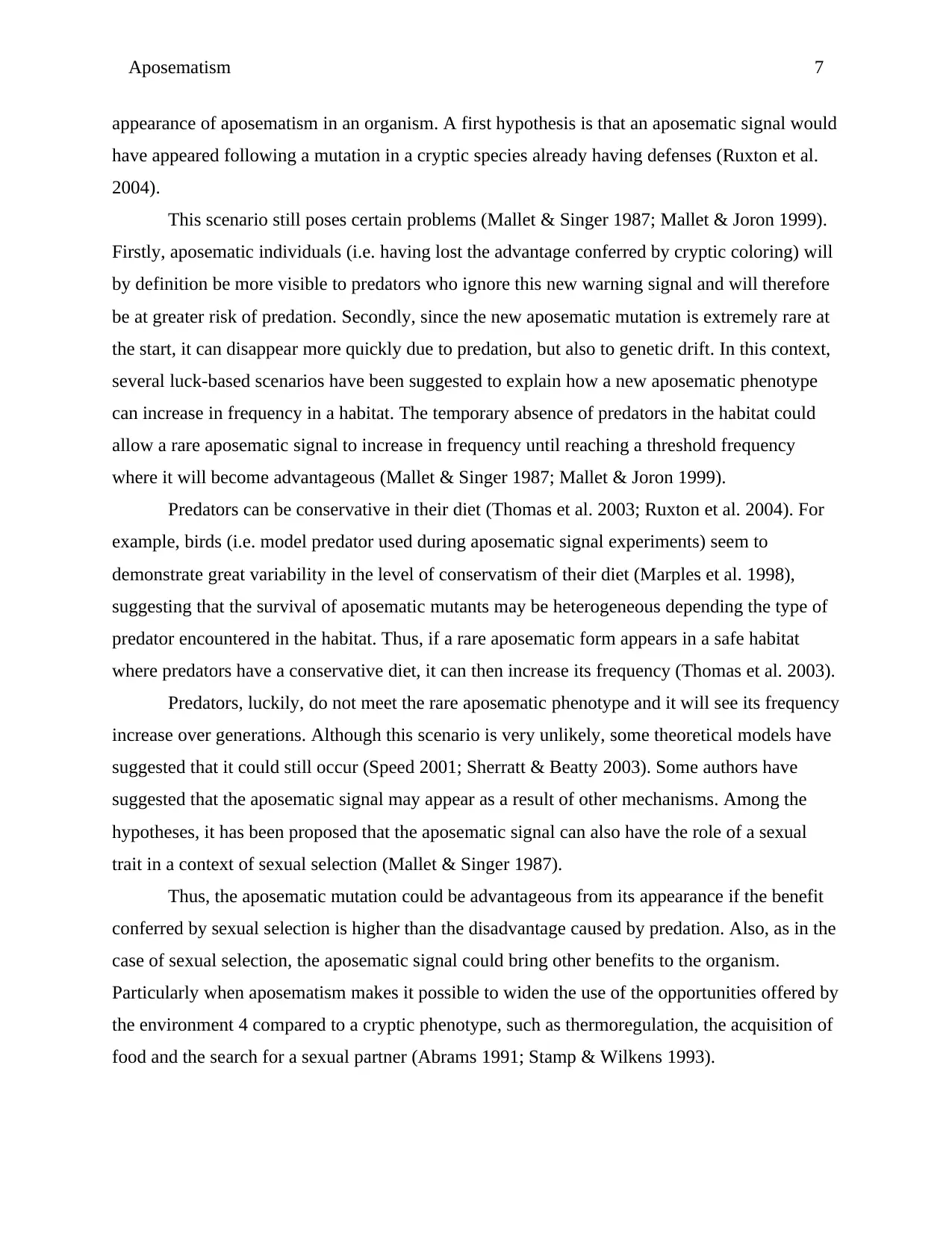
Aposematism 7
appearance of aposematism in an organism. A first hypothesis is that an aposematic signal would
have appeared following a mutation in a cryptic species already having defenses (Ruxton et al.
2004).
This scenario still poses certain problems (Mallet & Singer 1987; Mallet & Joron 1999).
Firstly, aposematic individuals (i.e. having lost the advantage conferred by cryptic coloring) will
by definition be more visible to predators who ignore this new warning signal and will therefore
be at greater risk of predation. Secondly, since the new aposematic mutation is extremely rare at
the start, it can disappear more quickly due to predation, but also to genetic drift. In this context,
several luck-based scenarios have been suggested to explain how a new aposematic phenotype
can increase in frequency in a habitat. The temporary absence of predators in the habitat could
allow a rare aposematic signal to increase in frequency until reaching a threshold frequency
where it will become advantageous (Mallet & Singer 1987; Mallet & Joron 1999).
Predators can be conservative in their diet (Thomas et al. 2003; Ruxton et al. 2004). For
example, birds (i.e. model predator used during aposematic signal experiments) seem to
demonstrate great variability in the level of conservatism of their diet (Marples et al. 1998),
suggesting that the survival of aposematic mutants may be heterogeneous depending the type of
predator encountered in the habitat. Thus, if a rare aposematic form appears in a safe habitat
where predators have a conservative diet, it can then increase its frequency (Thomas et al. 2003).
Predators, luckily, do not meet the rare aposematic phenotype and it will see its frequency
increase over generations. Although this scenario is very unlikely, some theoretical models have
suggested that it could still occur (Speed 2001; Sherratt & Beatty 2003). Some authors have
suggested that the aposematic signal may appear as a result of other mechanisms. Among the
hypotheses, it has been proposed that the aposematic signal can also have the role of a sexual
trait in a context of sexual selection (Mallet & Singer 1987).
Thus, the aposematic mutation could be advantageous from its appearance if the benefit
conferred by sexual selection is higher than the disadvantage caused by predation. Also, as in the
case of sexual selection, the aposematic signal could bring other benefits to the organism.
Particularly when aposematism makes it possible to widen the use of the opportunities offered by
the environment 4 compared to a cryptic phenotype, such as thermoregulation, the acquisition of
food and the search for a sexual partner (Abrams 1991; Stamp & Wilkens 1993).
appearance of aposematism in an organism. A first hypothesis is that an aposematic signal would
have appeared following a mutation in a cryptic species already having defenses (Ruxton et al.
2004).
This scenario still poses certain problems (Mallet & Singer 1987; Mallet & Joron 1999).
Firstly, aposematic individuals (i.e. having lost the advantage conferred by cryptic coloring) will
by definition be more visible to predators who ignore this new warning signal and will therefore
be at greater risk of predation. Secondly, since the new aposematic mutation is extremely rare at
the start, it can disappear more quickly due to predation, but also to genetic drift. In this context,
several luck-based scenarios have been suggested to explain how a new aposematic phenotype
can increase in frequency in a habitat. The temporary absence of predators in the habitat could
allow a rare aposematic signal to increase in frequency until reaching a threshold frequency
where it will become advantageous (Mallet & Singer 1987; Mallet & Joron 1999).
Predators can be conservative in their diet (Thomas et al. 2003; Ruxton et al. 2004). For
example, birds (i.e. model predator used during aposematic signal experiments) seem to
demonstrate great variability in the level of conservatism of their diet (Marples et al. 1998),
suggesting that the survival of aposematic mutants may be heterogeneous depending the type of
predator encountered in the habitat. Thus, if a rare aposematic form appears in a safe habitat
where predators have a conservative diet, it can then increase its frequency (Thomas et al. 2003).
Predators, luckily, do not meet the rare aposematic phenotype and it will see its frequency
increase over generations. Although this scenario is very unlikely, some theoretical models have
suggested that it could still occur (Speed 2001; Sherratt & Beatty 2003). Some authors have
suggested that the aposematic signal may appear as a result of other mechanisms. Among the
hypotheses, it has been proposed that the aposematic signal can also have the role of a sexual
trait in a context of sexual selection (Mallet & Singer 1987).
Thus, the aposematic mutation could be advantageous from its appearance if the benefit
conferred by sexual selection is higher than the disadvantage caused by predation. Also, as in the
case of sexual selection, the aposematic signal could bring other benefits to the organism.
Particularly when aposematism makes it possible to widen the use of the opportunities offered by
the environment 4 compared to a cryptic phenotype, such as thermoregulation, the acquisition of
food and the search for a sexual partner (Abrams 1991; Stamp & Wilkens 1993).
Paraphrase This Document
Need a fresh take? Get an instant paraphrase of this document with our AI Paraphraser
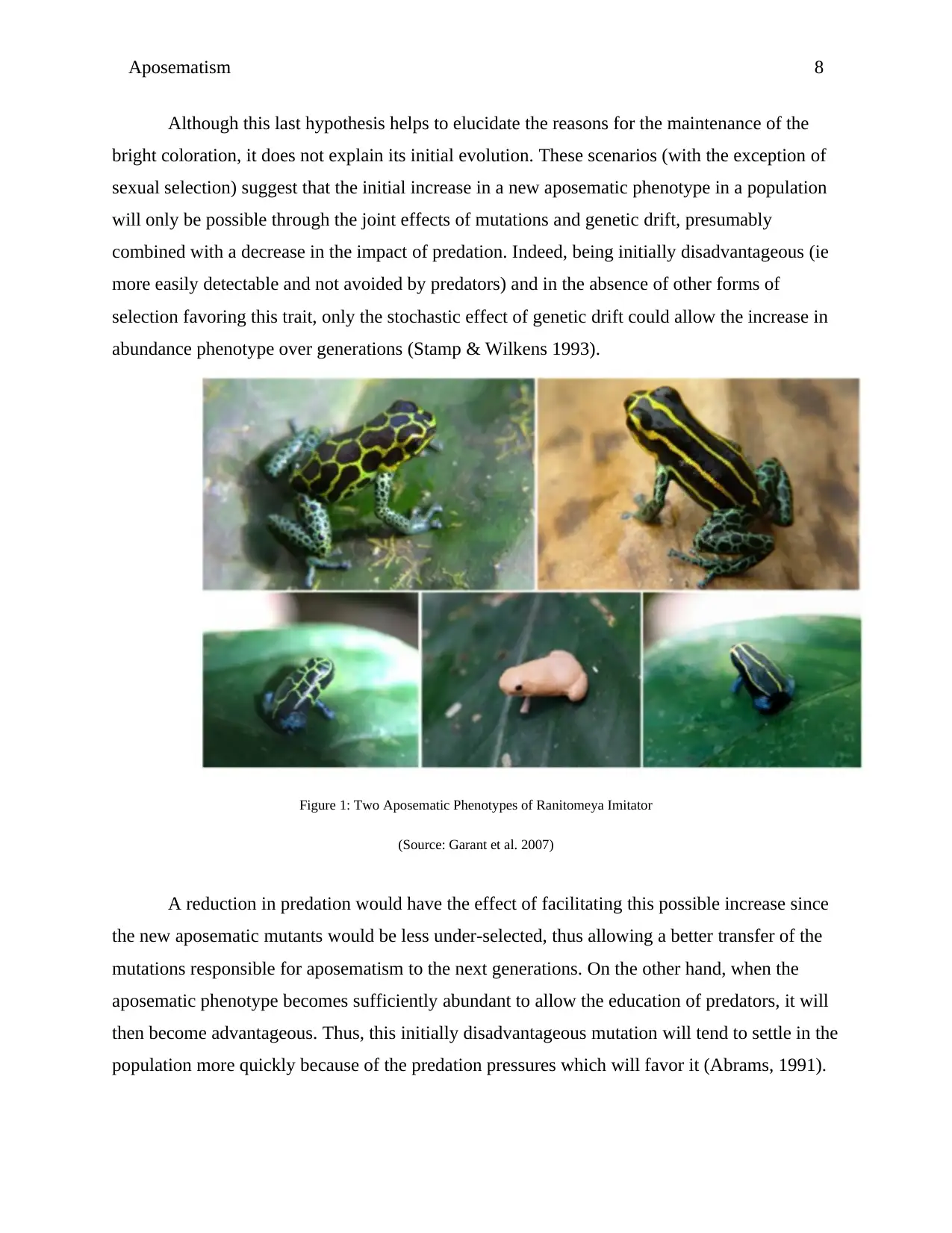
Aposematism 8
Although this last hypothesis helps to elucidate the reasons for the maintenance of the
bright coloration, it does not explain its initial evolution. These scenarios (with the exception of
sexual selection) suggest that the initial increase in a new aposematic phenotype in a population
will only be possible through the joint effects of mutations and genetic drift, presumably
combined with a decrease in the impact of predation. Indeed, being initially disadvantageous (ie
more easily detectable and not avoided by predators) and in the absence of other forms of
selection favoring this trait, only the stochastic effect of genetic drift could allow the increase in
abundance phenotype over generations (Stamp & Wilkens 1993).
Figure 1: Two Aposematic Phenotypes of Ranitomeya Imitator
(Source: Garant et al. 2007)
A reduction in predation would have the effect of facilitating this possible increase since
the new aposematic mutants would be less under-selected, thus allowing a better transfer of the
mutations responsible for aposematism to the next generations. On the other hand, when the
aposematic phenotype becomes sufficiently abundant to allow the education of predators, it will
then become advantageous. Thus, this initially disadvantageous mutation will tend to settle in the
population more quickly because of the predation pressures which will favor it (Abrams, 1991).
Although this last hypothesis helps to elucidate the reasons for the maintenance of the
bright coloration, it does not explain its initial evolution. These scenarios (with the exception of
sexual selection) suggest that the initial increase in a new aposematic phenotype in a population
will only be possible through the joint effects of mutations and genetic drift, presumably
combined with a decrease in the impact of predation. Indeed, being initially disadvantageous (ie
more easily detectable and not avoided by predators) and in the absence of other forms of
selection favoring this trait, only the stochastic effect of genetic drift could allow the increase in
abundance phenotype over generations (Stamp & Wilkens 1993).
Figure 1: Two Aposematic Phenotypes of Ranitomeya Imitator
(Source: Garant et al. 2007)
A reduction in predation would have the effect of facilitating this possible increase since
the new aposematic mutants would be less under-selected, thus allowing a better transfer of the
mutations responsible for aposematism to the next generations. On the other hand, when the
aposematic phenotype becomes sufficiently abundant to allow the education of predators, it will
then become advantageous. Thus, this initially disadvantageous mutation will tend to settle in the
population more quickly because of the predation pressures which will favor it (Abrams, 1991).
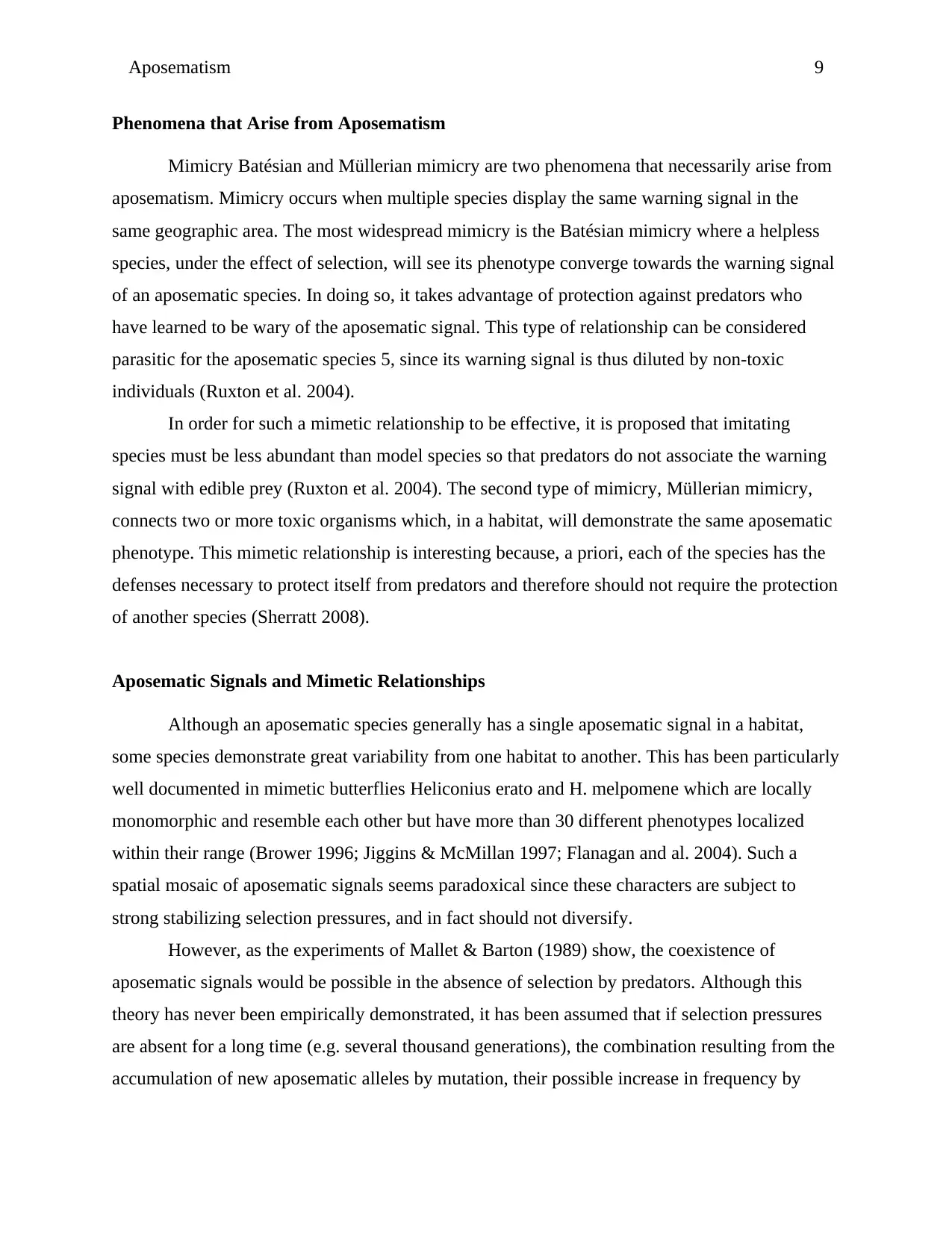
Aposematism 9
Phenomena that Arise from Aposematism
Mimicry Batésian and Müllerian mimicry are two phenomena that necessarily arise from
aposematism. Mimicry occurs when multiple species display the same warning signal in the
same geographic area. The most widespread mimicry is the Batésian mimicry where a helpless
species, under the effect of selection, will see its phenotype converge towards the warning signal
of an aposematic species. In doing so, it takes advantage of protection against predators who
have learned to be wary of the aposematic signal. This type of relationship can be considered
parasitic for the aposematic species 5, since its warning signal is thus diluted by non-toxic
individuals (Ruxton et al. 2004).
In order for such a mimetic relationship to be effective, it is proposed that imitating
species must be less abundant than model species so that predators do not associate the warning
signal with edible prey (Ruxton et al. 2004). The second type of mimicry, Müllerian mimicry,
connects two or more toxic organisms which, in a habitat, will demonstrate the same aposematic
phenotype. This mimetic relationship is interesting because, a priori, each of the species has the
defenses necessary to protect itself from predators and therefore should not require the protection
of another species (Sherratt 2008).
Aposematic Signals and Mimetic Relationships
Although an aposematic species generally has a single aposematic signal in a habitat,
some species demonstrate great variability from one habitat to another. This has been particularly
well documented in mimetic butterflies Heliconius erato and H. melpomene which are locally
monomorphic and resemble each other but have more than 30 different phenotypes localized
within their range (Brower 1996; Jiggins & McMillan 1997; Flanagan and al. 2004). Such a
spatial mosaic of aposematic signals seems paradoxical since these characters are subject to
strong stabilizing selection pressures, and in fact should not diversify.
However, as the experiments of Mallet & Barton (1989) show, the coexistence of
aposematic signals would be possible in the absence of selection by predators. Although this
theory has never been empirically demonstrated, it has been assumed that if selection pressures
are absent for a long time (e.g. several thousand generations), the combination resulting from the
accumulation of new aposematic alleles by mutation, their possible increase in frequency by
Phenomena that Arise from Aposematism
Mimicry Batésian and Müllerian mimicry are two phenomena that necessarily arise from
aposematism. Mimicry occurs when multiple species display the same warning signal in the
same geographic area. The most widespread mimicry is the Batésian mimicry where a helpless
species, under the effect of selection, will see its phenotype converge towards the warning signal
of an aposematic species. In doing so, it takes advantage of protection against predators who
have learned to be wary of the aposematic signal. This type of relationship can be considered
parasitic for the aposematic species 5, since its warning signal is thus diluted by non-toxic
individuals (Ruxton et al. 2004).
In order for such a mimetic relationship to be effective, it is proposed that imitating
species must be less abundant than model species so that predators do not associate the warning
signal with edible prey (Ruxton et al. 2004). The second type of mimicry, Müllerian mimicry,
connects two or more toxic organisms which, in a habitat, will demonstrate the same aposematic
phenotype. This mimetic relationship is interesting because, a priori, each of the species has the
defenses necessary to protect itself from predators and therefore should not require the protection
of another species (Sherratt 2008).
Aposematic Signals and Mimetic Relationships
Although an aposematic species generally has a single aposematic signal in a habitat,
some species demonstrate great variability from one habitat to another. This has been particularly
well documented in mimetic butterflies Heliconius erato and H. melpomene which are locally
monomorphic and resemble each other but have more than 30 different phenotypes localized
within their range (Brower 1996; Jiggins & McMillan 1997; Flanagan and al. 2004). Such a
spatial mosaic of aposematic signals seems paradoxical since these characters are subject to
strong stabilizing selection pressures, and in fact should not diversify.
However, as the experiments of Mallet & Barton (1989) show, the coexistence of
aposematic signals would be possible in the absence of selection by predators. Although this
theory has never been empirically demonstrated, it has been assumed that if selection pressures
are absent for a long time (e.g. several thousand generations), the combination resulting from the
accumulation of new aposematic alleles by mutation, their possible increase in frequency by
⊘ This is a preview!⊘
Do you want full access?
Subscribe today to unlock all pages.

Trusted by 1+ million students worldwide
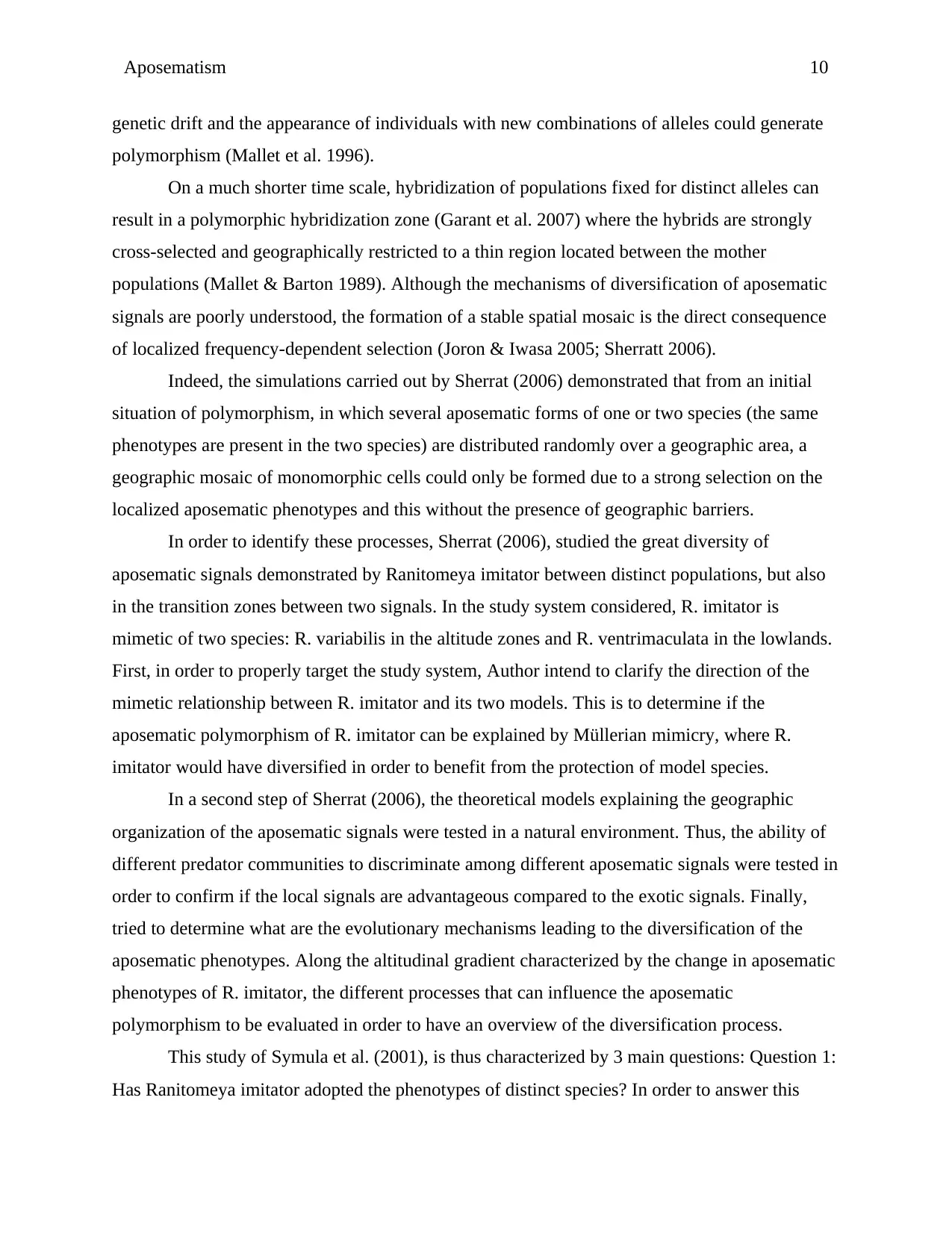
Aposematism 10
genetic drift and the appearance of individuals with new combinations of alleles could generate
polymorphism (Mallet et al. 1996).
On a much shorter time scale, hybridization of populations fixed for distinct alleles can
result in a polymorphic hybridization zone (Garant et al. 2007) where the hybrids are strongly
cross-selected and geographically restricted to a thin region located between the mother
populations (Mallet & Barton 1989). Although the mechanisms of diversification of aposematic
signals are poorly understood, the formation of a stable spatial mosaic is the direct consequence
of localized frequency-dependent selection (Joron & Iwasa 2005; Sherratt 2006).
Indeed, the simulations carried out by Sherrat (2006) demonstrated that from an initial
situation of polymorphism, in which several aposematic forms of one or two species (the same
phenotypes are present in the two species) are distributed randomly over a geographic area, a
geographic mosaic of monomorphic cells could only be formed due to a strong selection on the
localized aposematic phenotypes and this without the presence of geographic barriers.
In order to identify these processes, Sherrat (2006), studied the great diversity of
aposematic signals demonstrated by Ranitomeya imitator between distinct populations, but also
in the transition zones between two signals. In the study system considered, R. imitator is
mimetic of two species: R. variabilis in the altitude zones and R. ventrimaculata in the lowlands.
First, in order to properly target the study system, Author intend to clarify the direction of the
mimetic relationship between R. imitator and its two models. This is to determine if the
aposematic polymorphism of R. imitator can be explained by Müllerian mimicry, where R.
imitator would have diversified in order to benefit from the protection of model species.
In a second step of Sherrat (2006), the theoretical models explaining the geographic
organization of the aposematic signals were tested in a natural environment. Thus, the ability of
different predator communities to discriminate among different aposematic signals were tested in
order to confirm if the local signals are advantageous compared to the exotic signals. Finally,
tried to determine what are the evolutionary mechanisms leading to the diversification of the
aposematic phenotypes. Along the altitudinal gradient characterized by the change in aposematic
phenotypes of R. imitator, the different processes that can influence the aposematic
polymorphism to be evaluated in order to have an overview of the diversification process.
This study of Symula et al. (2001), is thus characterized by 3 main questions: Question 1:
Has Ranitomeya imitator adopted the phenotypes of distinct species? In order to answer this
genetic drift and the appearance of individuals with new combinations of alleles could generate
polymorphism (Mallet et al. 1996).
On a much shorter time scale, hybridization of populations fixed for distinct alleles can
result in a polymorphic hybridization zone (Garant et al. 2007) where the hybrids are strongly
cross-selected and geographically restricted to a thin region located between the mother
populations (Mallet & Barton 1989). Although the mechanisms of diversification of aposematic
signals are poorly understood, the formation of a stable spatial mosaic is the direct consequence
of localized frequency-dependent selection (Joron & Iwasa 2005; Sherratt 2006).
Indeed, the simulations carried out by Sherrat (2006) demonstrated that from an initial
situation of polymorphism, in which several aposematic forms of one or two species (the same
phenotypes are present in the two species) are distributed randomly over a geographic area, a
geographic mosaic of monomorphic cells could only be formed due to a strong selection on the
localized aposematic phenotypes and this without the presence of geographic barriers.
In order to identify these processes, Sherrat (2006), studied the great diversity of
aposematic signals demonstrated by Ranitomeya imitator between distinct populations, but also
in the transition zones between two signals. In the study system considered, R. imitator is
mimetic of two species: R. variabilis in the altitude zones and R. ventrimaculata in the lowlands.
First, in order to properly target the study system, Author intend to clarify the direction of the
mimetic relationship between R. imitator and its two models. This is to determine if the
aposematic polymorphism of R. imitator can be explained by Müllerian mimicry, where R.
imitator would have diversified in order to benefit from the protection of model species.
In a second step of Sherrat (2006), the theoretical models explaining the geographic
organization of the aposematic signals were tested in a natural environment. Thus, the ability of
different predator communities to discriminate among different aposematic signals were tested in
order to confirm if the local signals are advantageous compared to the exotic signals. Finally,
tried to determine what are the evolutionary mechanisms leading to the diversification of the
aposematic phenotypes. Along the altitudinal gradient characterized by the change in aposematic
phenotypes of R. imitator, the different processes that can influence the aposematic
polymorphism to be evaluated in order to have an overview of the diversification process.
This study of Symula et al. (2001), is thus characterized by 3 main questions: Question 1:
Has Ranitomeya imitator adopted the phenotypes of distinct species? In order to answer this
Paraphrase This Document
Need a fresh take? Get an instant paraphrase of this document with our AI Paraphraser
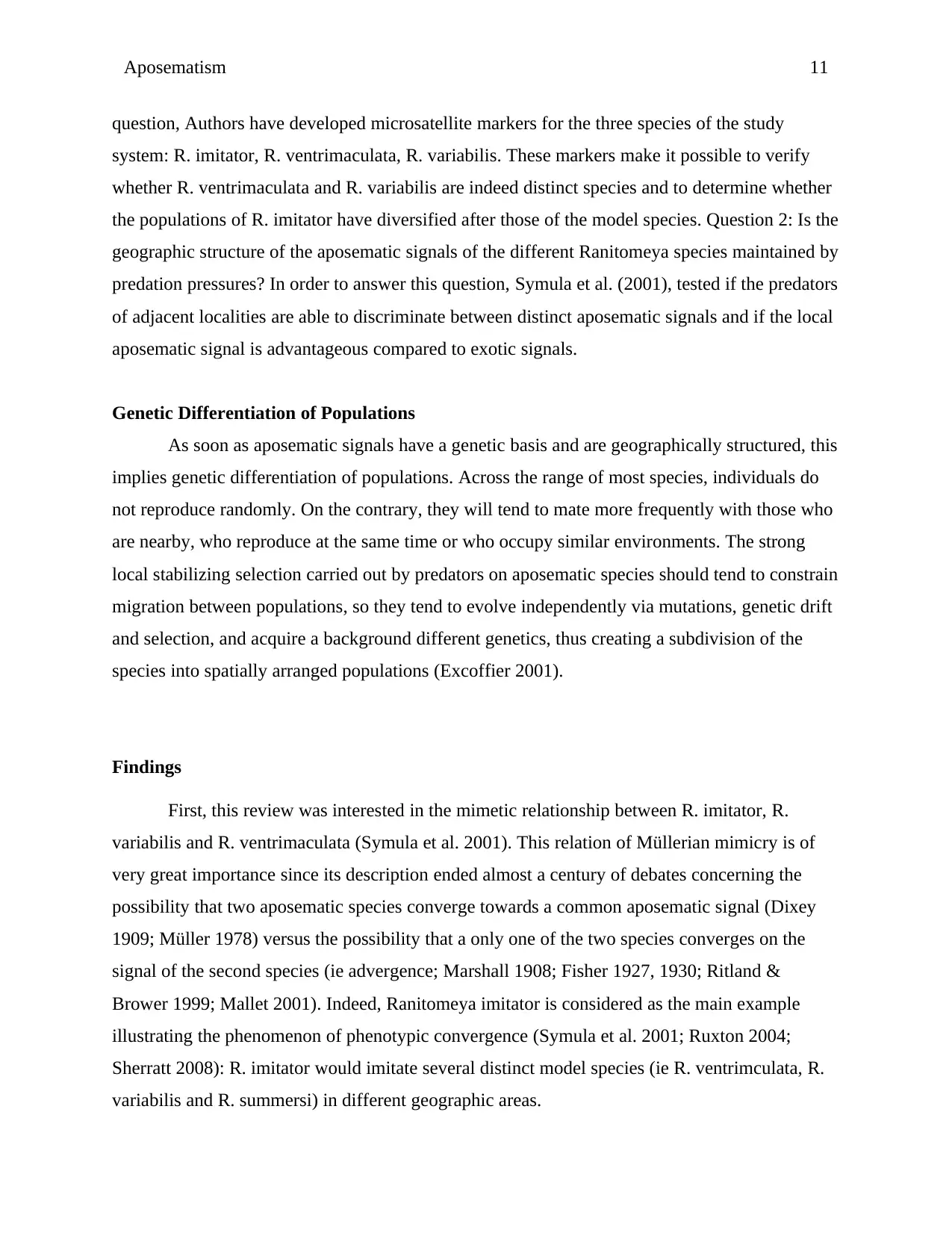
Aposematism 11
question, Authors have developed microsatellite markers for the three species of the study
system: R. imitator, R. ventrimaculata, R. variabilis. These markers make it possible to verify
whether R. ventrimaculata and R. variabilis are indeed distinct species and to determine whether
the populations of R. imitator have diversified after those of the model species. Question 2: Is the
geographic structure of the aposematic signals of the different Ranitomeya species maintained by
predation pressures? In order to answer this question, Symula et al. (2001), tested if the predators
of adjacent localities are able to discriminate between distinct aposematic signals and if the local
aposematic signal is advantageous compared to exotic signals.
Genetic Differentiation of Populations
As soon as aposematic signals have a genetic basis and are geographically structured, this
implies genetic differentiation of populations. Across the range of most species, individuals do
not reproduce randomly. On the contrary, they will tend to mate more frequently with those who
are nearby, who reproduce at the same time or who occupy similar environments. The strong
local stabilizing selection carried out by predators on aposematic species should tend to constrain
migration between populations, so they tend to evolve independently via mutations, genetic drift
and selection, and acquire a background different genetics, thus creating a subdivision of the
species into spatially arranged populations (Excoffier 2001).
Findings
First, this review was interested in the mimetic relationship between R. imitator, R.
variabilis and R. ventrimaculata (Symula et al. 2001). This relation of Müllerian mimicry is of
very great importance since its description ended almost a century of debates concerning the
possibility that two aposematic species converge towards a common aposematic signal (Dixey
1909; Müller 1978) versus the possibility that a only one of the two species converges on the
signal of the second species (ie advergence; Marshall 1908; Fisher 1927, 1930; Ritland &
Brower 1999; Mallet 2001). Indeed, Ranitomeya imitator is considered as the main example
illustrating the phenomenon of phenotypic convergence (Symula et al. 2001; Ruxton 2004;
Sherratt 2008): R. imitator would imitate several distinct model species (ie R. ventrimculata, R.
variabilis and R. summersi) in different geographic areas.
question, Authors have developed microsatellite markers for the three species of the study
system: R. imitator, R. ventrimaculata, R. variabilis. These markers make it possible to verify
whether R. ventrimaculata and R. variabilis are indeed distinct species and to determine whether
the populations of R. imitator have diversified after those of the model species. Question 2: Is the
geographic structure of the aposematic signals of the different Ranitomeya species maintained by
predation pressures? In order to answer this question, Symula et al. (2001), tested if the predators
of adjacent localities are able to discriminate between distinct aposematic signals and if the local
aposematic signal is advantageous compared to exotic signals.
Genetic Differentiation of Populations
As soon as aposematic signals have a genetic basis and are geographically structured, this
implies genetic differentiation of populations. Across the range of most species, individuals do
not reproduce randomly. On the contrary, they will tend to mate more frequently with those who
are nearby, who reproduce at the same time or who occupy similar environments. The strong
local stabilizing selection carried out by predators on aposematic species should tend to constrain
migration between populations, so they tend to evolve independently via mutations, genetic drift
and selection, and acquire a background different genetics, thus creating a subdivision of the
species into spatially arranged populations (Excoffier 2001).
Findings
First, this review was interested in the mimetic relationship between R. imitator, R.
variabilis and R. ventrimaculata (Symula et al. 2001). This relation of Müllerian mimicry is of
very great importance since its description ended almost a century of debates concerning the
possibility that two aposematic species converge towards a common aposematic signal (Dixey
1909; Müller 1978) versus the possibility that a only one of the two species converges on the
signal of the second species (ie advergence; Marshall 1908; Fisher 1927, 1930; Ritland &
Brower 1999; Mallet 2001). Indeed, Ranitomeya imitator is considered as the main example
illustrating the phenomenon of phenotypic convergence (Symula et al. 2001; Ruxton 2004;
Sherratt 2008): R. imitator would imitate several distinct model species (ie R. ventrimculata, R.
variabilis and R. summersi) in different geographic areas.
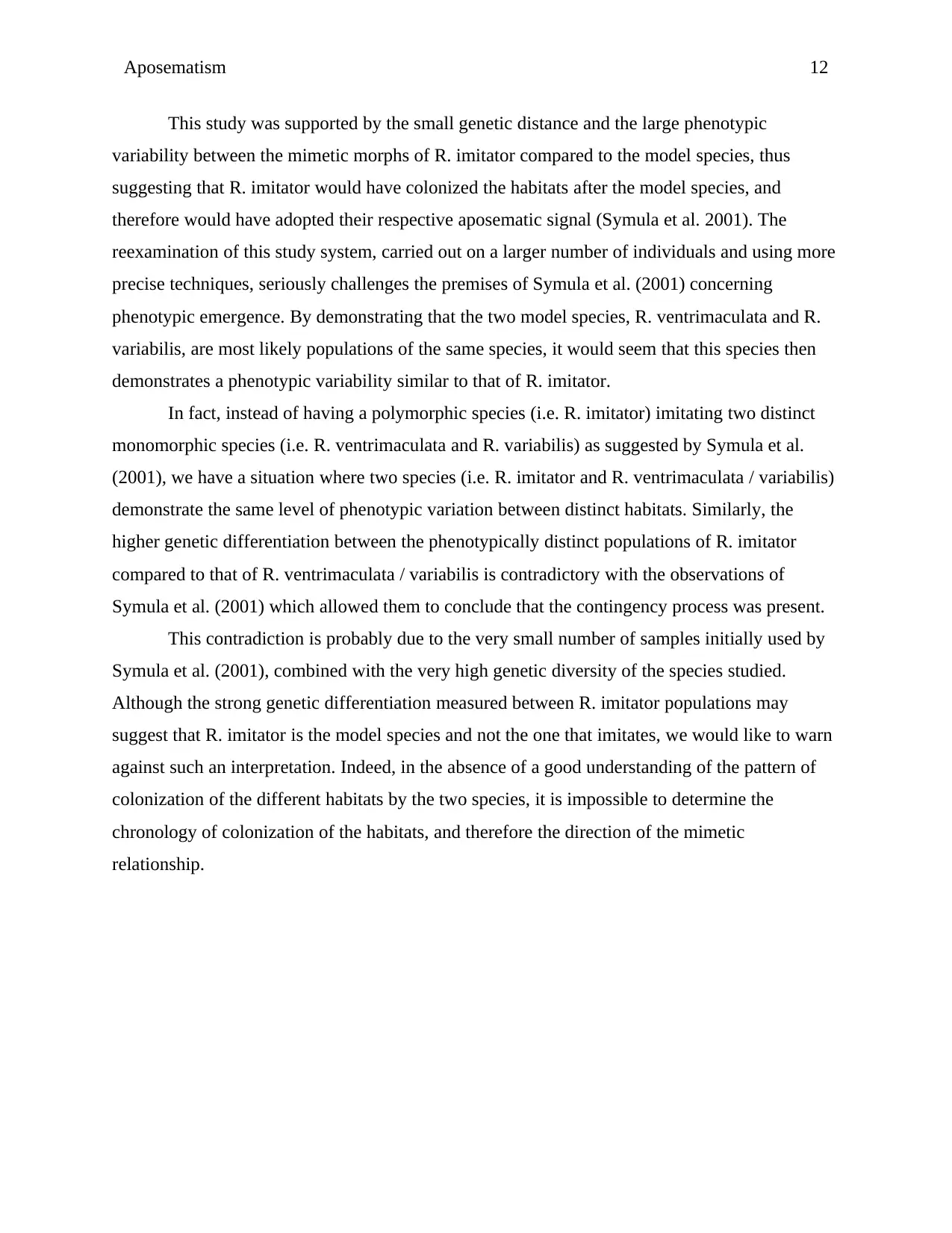
Aposematism 12
This study was supported by the small genetic distance and the large phenotypic
variability between the mimetic morphs of R. imitator compared to the model species, thus
suggesting that R. imitator would have colonized the habitats after the model species, and
therefore would have adopted their respective aposematic signal (Symula et al. 2001). The
reexamination of this study system, carried out on a larger number of individuals and using more
precise techniques, seriously challenges the premises of Symula et al. (2001) concerning
phenotypic emergence. By demonstrating that the two model species, R. ventrimaculata and R.
variabilis, are most likely populations of the same species, it would seem that this species then
demonstrates a phenotypic variability similar to that of R. imitator.
In fact, instead of having a polymorphic species (i.e. R. imitator) imitating two distinct
monomorphic species (i.e. R. ventrimaculata and R. variabilis) as suggested by Symula et al.
(2001), we have a situation where two species (i.e. R. imitator and R. ventrimaculata / variabilis)
demonstrate the same level of phenotypic variation between distinct habitats. Similarly, the
higher genetic differentiation between the phenotypically distinct populations of R. imitator
compared to that of R. ventrimaculata / variabilis is contradictory with the observations of
Symula et al. (2001) which allowed them to conclude that the contingency process was present.
This contradiction is probably due to the very small number of samples initially used by
Symula et al. (2001), combined with the very high genetic diversity of the species studied.
Although the strong genetic differentiation measured between R. imitator populations may
suggest that R. imitator is the model species and not the one that imitates, we would like to warn
against such an interpretation. Indeed, in the absence of a good understanding of the pattern of
colonization of the different habitats by the two species, it is impossible to determine the
chronology of colonization of the habitats, and therefore the direction of the mimetic
relationship.
This study was supported by the small genetic distance and the large phenotypic
variability between the mimetic morphs of R. imitator compared to the model species, thus
suggesting that R. imitator would have colonized the habitats after the model species, and
therefore would have adopted their respective aposematic signal (Symula et al. 2001). The
reexamination of this study system, carried out on a larger number of individuals and using more
precise techniques, seriously challenges the premises of Symula et al. (2001) concerning
phenotypic emergence. By demonstrating that the two model species, R. ventrimaculata and R.
variabilis, are most likely populations of the same species, it would seem that this species then
demonstrates a phenotypic variability similar to that of R. imitator.
In fact, instead of having a polymorphic species (i.e. R. imitator) imitating two distinct
monomorphic species (i.e. R. ventrimaculata and R. variabilis) as suggested by Symula et al.
(2001), we have a situation where two species (i.e. R. imitator and R. ventrimaculata / variabilis)
demonstrate the same level of phenotypic variation between distinct habitats. Similarly, the
higher genetic differentiation between the phenotypically distinct populations of R. imitator
compared to that of R. ventrimaculata / variabilis is contradictory with the observations of
Symula et al. (2001) which allowed them to conclude that the contingency process was present.
This contradiction is probably due to the very small number of samples initially used by
Symula et al. (2001), combined with the very high genetic diversity of the species studied.
Although the strong genetic differentiation measured between R. imitator populations may
suggest that R. imitator is the model species and not the one that imitates, we would like to warn
against such an interpretation. Indeed, in the absence of a good understanding of the pattern of
colonization of the different habitats by the two species, it is impossible to determine the
chronology of colonization of the habitats, and therefore the direction of the mimetic
relationship.
⊘ This is a preview!⊘
Do you want full access?
Subscribe today to unlock all pages.

Trusted by 1+ million students worldwide
1 out of 22
Your All-in-One AI-Powered Toolkit for Academic Success.
+13062052269
info@desklib.com
Available 24*7 on WhatsApp / Email
![[object Object]](/_next/static/media/star-bottom.7253800d.svg)
Unlock your academic potential
Copyright © 2020–2025 A2Z Services. All Rights Reserved. Developed and managed by ZUCOL.